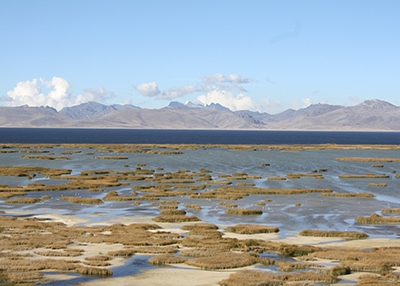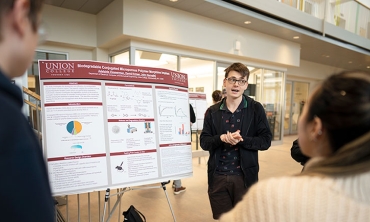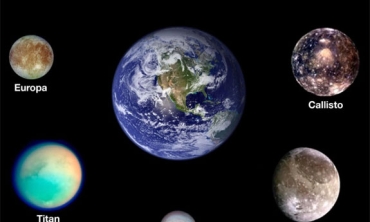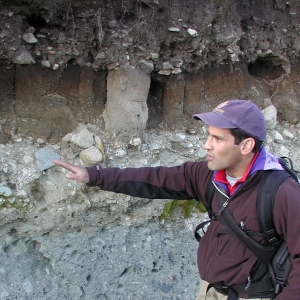For the first time, scientists can show that greenhouse gases have dragged the tropics – not just the polar regions – into synchronous climate change over much of the last million years, according to a paper published this week in Nature.
Donald T. Rodbell, the John and Jane Wold Professor of Geosciences at Union College, is the lead author of the paper that also shows that changes in the concentration of greenhouse gases (primarily CO2 and methane) have had a profound impact on synchronizing global climate.
“We now know that modest, natural changes in the concentration of these gases in the atmosphere, though far smaller than what is happening due to human activities today, was sufficient to alter global climates with almost no lag time,” Rodbell said.
Nature is regarded as the world’s leading journal of peer-reviewed science research. Rodbell’s paper is available at this link.
Rodbell discusses the research in this week's Nature Podcast.The paper is also the focus of a "News and Views" column on the Nature website.
The paper is based on data from fieldwork in 2015, when Rodbell led an international team of 30 scientists who collected a 100-meter deep sediment core from beneath Lake Junín, high in the Peruvian Andes. It was the first continuous record of tropical glaciation spanning the past 700,000 years.
For more on the 2015 Lake Junín drilling project, visit the fall 2015 issue of Union College magazine.
The Nature paper shows that tropical Andean glaciers waxed and waned in lockstep with the large ice sheets of the Northern Hemisphere and with temperature fluctuations at the South Pole, thus completing the picture of globally synchronous ice ages. Previously, much of what was known about glacial changes came from studies in the Northern Hemisphere.
“Although the history of the ice ages provides dramatic documentation of natural climate variability on a large scale, our understanding of this history has primarily come from the high latitude regions of the globe,” Rodbell said. “With this project, we know what happened during the ice ages in low latitude regions.”
Expanding glaciers leave a signature sediment type in the lake from the ground-up rock generated by their growth, Rodbell explained. When glaciers shrink and disappear, they leave a very different type of sediment, one dominated by calcium carbonate.
Rodbell’s team determined the age of sediment layers in the core using radiometric techniques such as radiocarbon and uranium-thorium dating coupled with paleomagnetic tools.
The international decade-long project was funded by the International Continental Scientific Drilling Program and the U.S. National Science Foundation. Union College was the lead institution. Other institutions involved include the University of Pittsburgh, Massachusetts Institute of Technology, the University of Florida, Oregon State University and the University of Minnesota.
This new study provides additional evidence that ice ages were not simply driven by changes in the annual distribution of solar radiation during regular orbital cycles 20,000 to 100,000 years long. Because these cycles produce patterns of solar radiation that vary by latitude, orbital variations alone would cause asynchronous ice ages across the globe.
“This documentation of tropical ice ages in synch with the rest of the globe provides an important test to the hypothesis that it was greenhouse gases that dragged the tropics (and the rest of the globe) along to follow the beat of the Northern Hemisphere ice sheets,” Rodbell said.
Ice cores from the polar regions of both hemispheres have shown that greenhouse gases were apparently tightly coupled to the expansion and contraction of the big ice sheets in the Northern Hemisphere.
Rodbell’s research over the last 35 years has focused on finding climate records in sediment layers from high altitude lakes and in cave deposits in the tropical Andes. In addition to records of glaciation, some of these records have documented the history of El Niño and La Niña events over the past 10,000 years.
Among the co-authors of the Nature paper are two Union alumni – Nicholas Weidhaas ’15 and Grace Delgado ’14 – both of whom participated in the 2015 drilling operation. Other students participated in core sampling trips to the University of Minnesota and/or pursued their senior thesis research projects on aspects of the drilling project. These include Erin Delman ’12, Dane O’Neil ’14, Tara Metzger ‘15, Laura Pacheco ‘16, Elise Farrington ’16, Liam Glennon ’17, Michael Kaye ’17, James Molloy ’17, Jordy Herbert ’18 and Tshering Lama Sherpa ’18.







